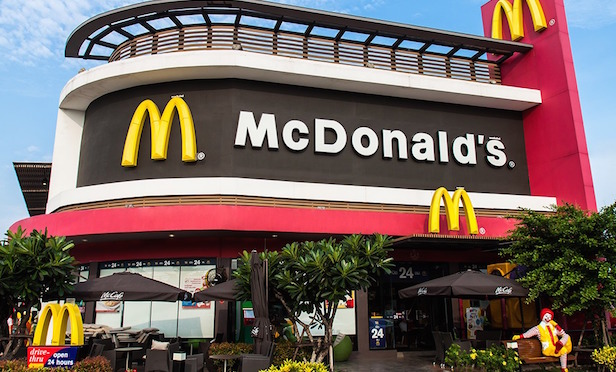 Transaction volume for quick-serve restaurant locations such as McDonald’s has grown dramatically in the past year, says Marcus & Millichap.
Transaction volume for quick-serve restaurant locations such as McDonald’s has grown dramatically in the past year, says Marcus & Millichap.
CALABASAS, CA—Continuing if steady rather than spectacular employment growth leading to increases in consumption and household formation, coupled with still-limited construction activity—all of these factors point to continued investor activity in net lease retail. That’s the case, says Marcus & Millichap, even amid concerns over tenant mergers and, in the case of quick-serve restaurants, minimum wages.
Furthermore, in its second-quarter report on the sector, Marcus & Millichap says in general it has been a lack of for-sale product, rather than a slowdown in demand, that has limited deal flow. An exception to that rule, though, is the dollar-store segment, for which the report cites a 23% year-over-year decline in transaction volume.
Largely to blame here is the recently completed union of Family Dollar and Dollar Tree; the combined entity is in the process of selling 330 locations, thus posing tenancy risk for stores flying the banner of either chain. “Net-leased buyers have opted to largely pursue other options in the sector, leading to a contraction of volume and sales activity,” according to Marcus & Millichap’s report. “This may continue for some time until investors are more confident in the outlook for store counts.”
Another segment where a merger hangs over the investment outlook is drugstores; here, it’s the proposed hook-up of Walgreens and smaller rival Rite Aid. Although the $17-billion combination hasn’t yet gotten a sign-off from antitrust regulators, “investors have had to confront the possibility of store closures in some markets as a result of an approval,” the report states. Nonetheless, safety of yield is encouraging net-lease investors to continue deploying capital in the drugstore space.
For the quick-serve segment, it’s possible that state-level laws under consideration to raise the minimum wage to $15 per hour may slow deal volume. To date, however, this hasn’t happened: Marcus & Millichap noted that deal flow has been up “dramatically” over the past year, while cap rates have fallen into the low- to mid-5% range—and lower still in the case of the most desirable McDonald’s and Starbucks locations. “Considering bars and restaurants have been a leading retail growth sector, the outlook for these and other net-leased assets remains strong,” according to the report.
More broadly, the report charts some of the ongoing drivers of investment in net-leased retail properties. “As a growing number of property owners near retirement, many are choosing to transition their investment portfolios from apartment assets that are trading at a premium into net-leased retail properties,” often via 1031 exchanges.
Benefits of investing in the sector can include “higher initial yields than other low-maintenance options and reduced volatility relative to other property types.” The net lease sector offers investors a wide range of choices, with cap rates averaging in the mid-5% range, depending on the property’s location and tenancy.
“Although cap rates are likely to remain stable due to the tight spread between credit financing and prices, willing investors continue to actively search for attractive offerings,” according to Marcus & Millichap. “With several states considering more stringent definitions of like-kind exchanges, potentially limiting where acquisitions can be made, the current demand for net-leased properties remains robust.”

















 Copyright © 2024 ALM Global, LLC. All Rights Reserved.
Copyright © 2024 ALM Global, LLC. All Rights Reserved.